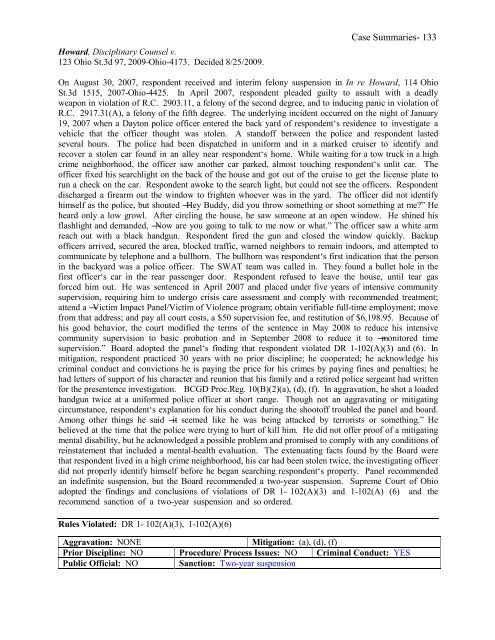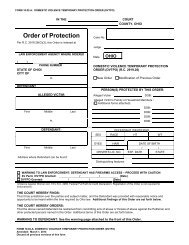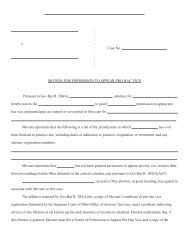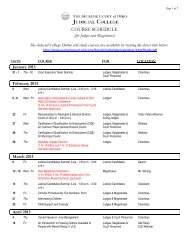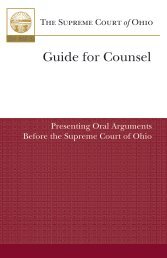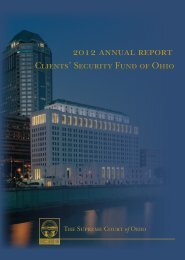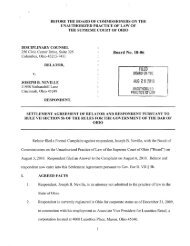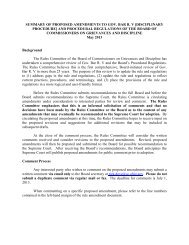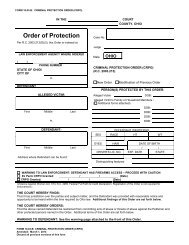disciplinary handbook: volume v - Supreme Court - State of Ohio
disciplinary handbook: volume v - Supreme Court - State of Ohio
disciplinary handbook: volume v - Supreme Court - State of Ohio
You also want an ePaper? Increase the reach of your titles
YUMPU automatically turns print PDFs into web optimized ePapers that Google loves.
Howard, Disciplinary Counsel v.123 <strong>Ohio</strong> St.3d 97, 2009-<strong>Ohio</strong>-4173. Decided 8/25/2009.Case Summaries- 133On August 30, 2007, respondent received and interim felony suspension in In re Howard, 114 <strong>Ohio</strong>St.3d 1515, 2007-<strong>Ohio</strong>-4425. In April 2007, respondent pleaded guilty to assault with a deadlyweapon in violation <strong>of</strong> R.C. 2903.11, a felony <strong>of</strong> the second degree, and to inducing panic in violation <strong>of</strong>R.C. 2917.31(A), a felony <strong>of</strong> the fifth degree. The underlying incident occurred on the night <strong>of</strong> January19, 2007 when a Dayton police <strong>of</strong>ficer entered the back yard <strong>of</strong> respondent‘s residence to investigate avehicle that the <strong>of</strong>ficer thought was stolen. A stand<strong>of</strong>f between the police and respondent lastedseveral hours. The police had been dispatched in uniform and in a marked cruiser to identify andrecover a stolen car found in an alley near respondent‘s home. While waiting for a tow truck in a highcrime neighborhood, the <strong>of</strong>ficer saw another car parked, almost touching respondent‘s unlit car. The<strong>of</strong>ficer fixed his searchlight on the back <strong>of</strong> the house and got out <strong>of</strong> the cruise to get the license plate torun a check on the car. Respondent awoke to the search light, but could not see the <strong>of</strong>ficers. Respondentdischarged a firearm out the window to frighten whoever was in the yard. The <strong>of</strong>ficer did not identifyhimself as the police, but shouted ―Hey Buddy, did you throw something or shoot something at me?‖ Heheard only a low growl. After circling the house, he saw someone at an open window. He shined hisflashlight and demanded, ―Now are you going to talk to me now or what.‖ The <strong>of</strong>ficer saw a white armreach out with a black handgun. Respondent fired the gun and closed the window quickly. Backup<strong>of</strong>ficers arrived, secured the area, blocked traffic, warned neighbors to remain indoors, and attempted tocommunicate by telephone and a bullhorn. The bullhorn was respondent‘s first indication that the personin the backyard was a police <strong>of</strong>ficer. The SWAT team was called in. They found a bullet hole in thefirst <strong>of</strong>ficer‘s car in the rear passenger door. Respondent refused to leave the house, until tear gasforced him out. He was sentenced in April 2007 and placed under five years <strong>of</strong> intensive communitysupervision, requiring him to undergo crisis care assessment and comply with recommended treatment;attend a ―Victim Impact Panel/Victim <strong>of</strong> Violence program; obtain verifiable full-time employment; movefrom that address; and pay all court costs, a $50 supervision fee, and restitution <strong>of</strong> $6,198.95. Because <strong>of</strong>his good behavior, the court modified the terms <strong>of</strong> the sentence in May 2008 to reduce his intensivecommunity supervision to basic probation and in September 2008 to reduce it to ―monitored timesupervision.‖ Board adopted the panel‘s finding that respondent violated DR 1-102(A)(3) and (6). Inmitigation, respondent practiced 30 years with no prior discipline; he cooperated; he acknowledge hiscriminal conduct and convictions he is paying the price for his crimes by paying fines and penalties; hehad letters <strong>of</strong> support <strong>of</strong> his character and reunion that his family and a retired police sergeant had writtenfor the presentence investigation. BCGD Proc.Reg. 10(B)(2)(a), (d), (f). In aggravation, he shot a loadedhandgun twice at a uniformed police <strong>of</strong>ficer at short range. Though not an aggravating or mitigatingcircumstance, respondent‘s explanation for his conduct during the shoot<strong>of</strong>f troubled the panel and board.Among other things he said ―it seemed like he was being attacked by terrorists or something.‖ Hebelieved at the time that the police were trying to hurt <strong>of</strong> kill him. He did not <strong>of</strong>fer pro<strong>of</strong> <strong>of</strong> a mitigatingmental disability, but he acknowledged a possible problem and promised to comply with any conditions <strong>of</strong>reinstatement that included a mental-health evaluation. The extenuating facts found by the Board werethat respondent lived in a high crime neighborhood, his car had been stolen twice, the investigating <strong>of</strong>ficerdid not properly identify himself before he began searching respondent‘s property. Panel recommendedan indefinite suspension, but the Board recommended a two-year suspension. <strong>Supreme</strong> <strong>Court</strong> <strong>of</strong> <strong>Ohio</strong>adopted the findings and conclusions <strong>of</strong> violations <strong>of</strong> DR 1- 102(A)(3) and 1-102(A) (6) and therecommend sanction <strong>of</strong> a two-year suspension and so ordered.Rules Violated: DR 1- 102(A)(3), 1-102(A)(6)Aggravation: NONEMitigation: (a), (d), (f)Prior Discipline: NO Procedure/ Process Issues: NO Criminal Conduct: YESPublic Official: NO Sanction: Two-year suspension


